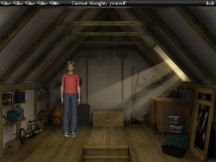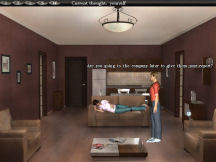Many people have tried to write games
that exemplify the conspiracy theory plot. Recent examples include The
Moment of Silence and Broken Sword: The Angel of Death. But I
can't think of any other quite like Diamonds in the Rough (to be
known, henceforth, as DitR). This is an 'indie' game, produced by a
small Greek company led by Alkis Polyrakis, called Atropos Studios. The
studio is named after the third of the three Fates of Greek myth (the
others being Clotho and Lachesis) who cuts the life-thread of humans, and
from whom we get the word 'atrophy' – to wither away. Mind you, even after
completing DitR, I'm still not quite sure if the company name has
any bearing upon the game.
Diamonds in the Rough
was written using the Adventure Game Studio (AGS) product by Chris Jones.
The AGS has been around for over ten years now, and has supported the
creation of many amateur adventure games. Few have gone on to commercial
production. However, this is not to suggest that DitR is in any way
an amateur game. As you will see, it is much more than that.
Where to begin?
The lead
character, Jason Hart, has been hired to join a company called “Diamonds
in the Rough,” doing what appears to be research into paranormal and
psychic powers. He finds himself living in the middle of nowhere, with a
comfortable life in luxurious surroundings, doing simple tasks. However,
the community is completely isolated from the rest of the world.
The game actually begins with Jason sitting facing you,
beginning the process of committing suicide by poisoning himself. Oooh,
what a lovely way to start a story! He proceeds to introduce his life, the
company, the start of his experiences at DitR, and his dealings
with the people there. Your own involvement is to drive the story in his
memory with flash-forward cut scenes, as Jason reveals more of the plot.
There are a variety of other characters about town, most of
whom you'll interact with, and a few you won't. Some of them are employees
of DitR that have 'special abilities' like Jason, whilst others are
more conventional employees. You see, the company Diamonds in the Rough
employs people with paranormal or psychic powers, though it will take you
a long time to find out just why the company is doing this.
How do you play?
DitR
is a traditional
point-n-click game. There is some limited typing on the keyboard for a few
codes in the game, and there are keyboard shortcuts for various functions.
But primarily this is a mouse driven game. In fact, I played the bulk of
the game entirely with the mouse, having done the standard geek thing of
not bothering with the game manual (on the CD) until after I had completed
the game, at which point there were several “d'oh!” moments as I realised
the keyboard shortcuts would have been useful.
Like many modern point-n-click games, the mouse pointer
takes several forms. However, switching between forms is user-controlled
(either by right clicking, or by keyboard shortcut); it is not automatic.
You can speak to people (using the mouth cursor), walk places (the
footprint cursor), look at things (the eye cursor), interact with things
(the hand cursor), and think about people and things (the post-it note
cursor). Ah! The post-it note. This is where DitR starts to take a
new line relative to most of the adventure games I've played.
As the player, you have access to a corkboard that forms a
second inventory -- but rather than objects, it is thoughts that are
stored here. As the story progresses, you will uncover people and concepts
that are stored on the corkboard. When a new thought is added to the
board, you'll see a light bulb go on above Jason's head (along with a
sound effect). Now you have an additional list of things (coloured
post-its) which you can apply to people, things in the environment, and
items in your conventional inventory.
There are so many combinations possible with this new pair
of inventories, that the old strategy of 'use every inventory item with
every object in the scene' will get you nowhere fast. There is an
explosion of possibilities, which made knowing what to do next quite hard
to figure out. In fact, I had to resort to a walkthrough on a couple of
occasions to figure out how to proceed. Ironically, the puzzle described
(when I read about it afterwards) as the 'most difficult in the game'
actually fell reasonably easily to a logical approach.
The environment in which you play (and in which Jason and
his colleagues live) is a small, sunny community with buildings of a
variety of styles from around Europe; some modern, and some old. The
graphics appear to be pre-rendered backgrounds, with people added in
appropriate locations, and Jason is animated over the top. Few of the
people move much – the exception being Jason. For most people their
movements are limited to a form of rough lip-sync with their voice. Jason
is at least shown walking around his environment, and interacting with
items. This is one area that lets DitR down in comparison with
other games on the market, but to be fair to the developers, they weren't
exactly working with an Eidos or EA Games-scale team, resources, or
budget!
Of course, as Jason can speak to people around the town,
there is the inevitable dialogue tree to be negotiated. But the tree is
not deep, nor too onerous, and there's always the Escape key or left-click
to skip the speech if you're a fast reader of subtitles. Be warned,
however, the denouement takes quite some time to play out, as there is a
lot of explaining to be done about the nature of the company and its
activities.
In order to configure the options for DitR, you'll
need to do a little hunting to find a program called winsetup in
the installation directory of the game. Actually, there's not much chance
you'll need to alter any settings, unless you're using a really old PC
that can't handle an 800x600 display.
The only options configurable from within the game are the
sound volume and the subtitles. The sound volume is adjusted using the
first five number keys (1 – 5), and the subtitle toggle is F8. For the
complete list of keys, I recommend reading the short manual on the CD or
in the installation directory of the game.
Any other novelties?
The key
novelties in DitR are the inventory of thoughts and the unusual
story. The conclusion to the story is rather disturbing and shocking, but
well worth the effort. This is clearly a story that has been carefully
crafted from extensive research and study.
The
technical presentation throughout the game -- the music and voice acting
in particular -- deserves special notice. I've played many games where the
actors “phone-in” their lines, and the music is forgettable, but both here
show a professionalism well beyond the expected, even if some of the
accents were not to my taste. Furthermore, I found no evidence of bugs
anywhere in the game. It never crashed, hung, or blue-screened my PC.
Conclusions
I have a lot of respect for independent developers. They
perform a vital and vitalising service for the games industry and for
gamers. They show the level of artistry that can be achieved by people
with passion and dedication but not much money. Very often, they put the
'professionals' to shame, releasing finely crafted, glitch-free software
that provides us, the gamers, with hours of pleasure, frustration (in the
good 'I want to figure this puzzle out on my own' way), reward and
challenge.
It makes me happy to report that Alkis Polyrakis and his
small team at Atropos Studios are exemplars of this description.
Diamonds in the Rough is a thought-provoking (nay, scary) story
about... well, I can't say any more than that for fear of getting midnight
visits from serious men with serious expressions wearing serious suits
with serious bulges where one oughtn't normally to see bulges, if you see
what I mean!
Suffice it to say that the comment: ”Oh, I saw that ending
coming from a mile away,” is not going to be a common response to this
game.
There's only one feature of this game that I'd like to see
get fixed, and that would be the addition of a simple date & time label on
the picture associated with each saved game. As it stands, if you don't
label your saves, it can be hard to tell which is the most recent.
To sum up: the environments are excellent, the music varied
and appropriate. The voice acting is consistently good, though some of the
accents were not to my taste. Technically, the only letdowns were the very
static environment and the low quality in the animation of Jason Hart.
However, bearing in mind that this is not a Triple-A release by a major
studio, but an independent release by a small team, it is very good, hence
the grade I've chosen.
Grade: B
What do you need to play it?
Minimum
Requirements:
-
Windows
98/Me/2000/XP/VISTA with DirectX 5 or above
-
Pentium IV 1GHz CPU or
equivalent
-
DirectX-compatible
graphics card with 64MB of RAM or more and supporting 24-bit colour
-
128 MB RAM
-
Screen resolution of at
least 800x600
-
360MBs of free space
Recommended Requirements:
-
Pentium IV 1.8GHz CPU
or equivalent
-
DirectX-compatible
graphics card with 128MB of RAM or more and supporting 24-bit colour
-
256 MB RAM
-
DirectX compatible Sound Card
(I used a
custom built Win XP Pro SP2, AMD Athlon 64 3500+, 1024 MB RAM, and ATI
X1950Pro 512MB video card)
May 2008
design copyright ©
2008
GameBoomers
Group



